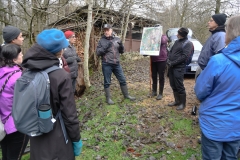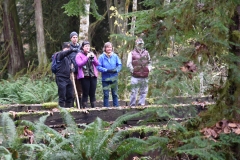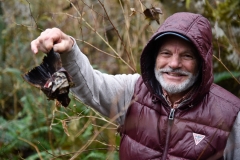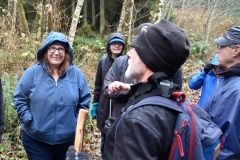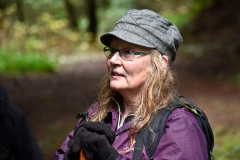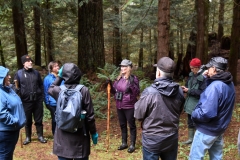First in a series
The Department of Fisheries and Oceans slapped a ban on both personal and commercial shellfish harvesting throughout Baynes Sound this week because Sunday’s heavy rainfall, which came “after a prolonged dry spell,” will “adversely affect marine water quality.”
It’s a regular notice the DFO issues around most urbanized regions of Vancouver Island this time of year, and it usually lasts for more than a few days.
Why? Because every time it rains after a dry period, it’s as if a giant toilet flushes animal feces, fertilizers, pesticides, oils, road salts, heavy metals and other contaminants into our municipal stormwater systems, which in turn send torrents of polluted water directly into our watersheds, killing fish, eroding property and making our waters unsafe for shellfish harvesting.
This is not a new problem. For the past 100 years, urban development has replaced natural vegetated land with impervious surfaces like roads and parking lots. This has diminished the amount of rainwater absorbed into the ground and reduced the dispersal of precipitation back into the atmosphere from trees, which do the heavy lifting, and other plants, via a process called evapotranspiration.

As a result, surface runoff has become the primary means of rainwater drainage.
To control flooding, Comox Valley municipalities, like other local governments around the world, invested millions of dollars over time in underground infrastructure to channel rainwater runoff into rivers or streams. This not only polluted these waterways and killed wildlife, but the increased volume and speed of the moving water caused erosion and other flooding risks by altering the natural hydrologic cycle.
Even today, when streams get in the way of development, they are often diverted into pipes and buried beneath buildings and parking lots, which greatly increases the flow rate of stormwater and is more likely to cause erosion in a stream’s natural sections.
Comox’s Golf Creek is a prime example. Eighty-six percent of the once flourishing natural stream flowing into Comox Harbor has been buried beneath residential streets, the Comox Mall and the Berwick Retirement Community. It’s polluted after heavy rains and a downstream property owner is currently suing the town over erosion caused by the creek’s sudden fast flows and large volumes.
Former Comox Department of Fisheries and Oceans Officer Chris Hilliar says the problem with stormwater runoff is just the story of urban development gone wrong.
“Humans have an order to their development process: first we log it, then we farm it, then we pave it,” he told Decafnation. “Fish can get along with forestry, if it’s done right; they can get along with farming, if it’s done right; but, concrete and pavement are killers, a death knell to streams and the aquatic life within them.”
The list of problems caused by contaminated stormwater runoff goes beyond erosion and flooding.
Stormwater runoff is the main reason why many urban streams are devoid of fish or linger on aquatic life-support, and why these streams can pose a public health risk for children who play in them.
Stormwater runoff is the top non-point source of oil from human activity into North America’s oceans, according to the National Research Council. And it has been identified as the source of polychlorinated biphenyls (PCBs) that are harming British Columbia’s killer whale population, according to another NRC paper.
“It’s an iterative process. Every municipality is on a continuum of change; modernizing, moving forward with advances in knowledge” — Ryan O’Grady
It sounds like an irreversible situation whose remedy is too expensive to undertake. In a 2012 meeting with the Comox Valley Conservation Partnership, Town of Comox Public Works Superintendent Glenn Westendorp said the municipality was facing about $160 million in unfunded infrastructure liabilities that include fixing and replacing stormwater pipes.
“We know the bill is coming to us down the road and we don’t see the means of paying for it,” Westendorp was quoted as saying in the society’s newsletter.
But a shift in thinking about traditional methods of handling stormwater began to occur during the 1980s and 1990s toward constructing wetlands and ponds to detain rainwater long enough for contaminates to settle out and allow some water to infiltrate back into the ground. This gave hope there was a means of cleaning our streams and extending the life of municipal infrastructure.
Today, there’s been a further shift toward a recognition that nature itself cleans and controls rainwater better than any engineered solution. This new emphasis attempts to imitate nature with pervious surfaces, downspout disconnection, rain gardens, bioswales, green roofs and rainwater harvesting. And the prospects have excited many municipal engineers and environmentalists.
But the wheels of change turn slowly.
“Any change in regulations, such as we’re seeing for stormwater, does not go from 0 to 100 miles per hour,” Ryan O’Grady, Courtenay’s director of engineering services told Decafnation. “It’s an iterative process. Every municipality is on a continuum of change; modernizing, moving forward with advances in knowledge.”
And change also requires elected officials to pass new policies and update bylaws that give municipal staff the authority to require LID and green infrastructure. Without legal regulations, not all developers and property owners will embrace the movement, because these rainwater features take up space that some are loathe to forfeit.
Local governments have made progress
Almost all BC communities now follow a method that measures its organizational capacity for maintaining infrastructure to ensure sustainable service delivery. It’s a framework that Courtenay Chief Administration Officer David Allen helped create in his role as Co-Chair of Asset Management BC.
And Courtenay has launched a pilot project with the Municipal Natural Assets Initiative, which attempts to value a municipalities’ natural assets and is working with the Public Sector Accounting Board to change accounting methods to allow for this approach.
“We are using these methods to develop ways to use a combination of engineered assets and natural assets to replace our existing stormwater and flood management systems,” Allen told Decafnation.
In its recently completed renovation of Fifth Street, the City of Courtenay narrowed the roadway (reducing impervious surface area) and added rain gardens to capture runoff and encourage infiltration. The city plans to develop its first Integrated Stormwater Management Plan in 2019 that could set a new, greener standard for stormwater management in the municipality.
The Town of Comox has developed a Stormwater Management Plan for the North East Comox Neighbourhood — lands near the Comox Airport — that incorporates the latest best practices for low-impact development (LID) and green infrastructure regulations, although these have not yet been made into enforceable bylaws.
Cumberland added bioswales along Bevan and Cumberland roads when they were renovated in 2017, and may include rain gardens in its upcoming downtown redevelopment plan.
Other communities have taken big leaps forward
The City Victoria has created a new utility tax to fund its future cost of maintaining stormwater infrastructure and to encourage residents and developers to adopt green infrastructure and low-impact development designs. In most communities, stormwater infrastructure costs are paid out of general revenue.
Victoria residents are now taxed separately for the stormwater that leaves their property. In other words, the more impervious surfaces and the fewer onsite mitigations you have, such as rain gardens and rock pits, the more you will pay.
Victoria joined Richmond, BC, and hundreds of other cities across Canada and the world that now expect residents and developers to manage their own rainwater, lessening the burden on municipalities.
It’s the theory behind Chinese landscape architect Kongjian Yu’s “sponge cities” concept, a way to describe the capacity of an urban landscape to absorb rainwater naturally. Major world cities have jumped on the idea. Berlin, Germany, adopted a city-wide Sponge City Strategy in 2017.
Since 2009, Toronto, Ont. has required buildings over 2,000 square metres to have green roofs, which use several layers of soil to grow plants that capture and release rainwater, slowing the rush of water through the city’s stormwater pipes.
The list and variety of innovations for managing stormwater through green infrastructure is long and growing.
Municipalities in the Comox Valley and elsewhere have focused heavily on drinking water and wastewater treatment in the past. But now their attention has turned sharply toward improving how we manage stormwater.
The change may seem to be coming too late for streams, like Golf Creek in Comox, that are almost entirely buried and channelized. But challenging initiatives like the 100-year plan to restore Bowker Creek in Victoria and the campaign to save the Morrision Creek headwaters between Courtenay and Cumberland may someday restore fish in our streams and keep our waters open to shellfish harvesting.

 Of course, Cumberland already had the most functionally progressive council in the Valley, and had only one change after the election — Vickey Brown for Roger Kishi. Courtenay has three new councillors and Comox has four.
Of course, Cumberland already had the most functionally progressive council in the Valley, and had only one change after the election — Vickey Brown for Roger Kishi. Courtenay has three new councillors and Comox has four.


 The Comox Valley Sewer Service (CVSS) serves the City of Courtenay, Town of Comox, K’omoks First Nation and CFB Comox. Residents of Area A, B and C rural electoral areas manage their own wastewater with about 10,000 private septic systems.
The Comox Valley Sewer Service (CVSS) serves the City of Courtenay, Town of Comox, K’omoks First Nation and CFB Comox. Residents of Area A, B and C rural electoral areas manage their own wastewater with about 10,000 private septic systems.


